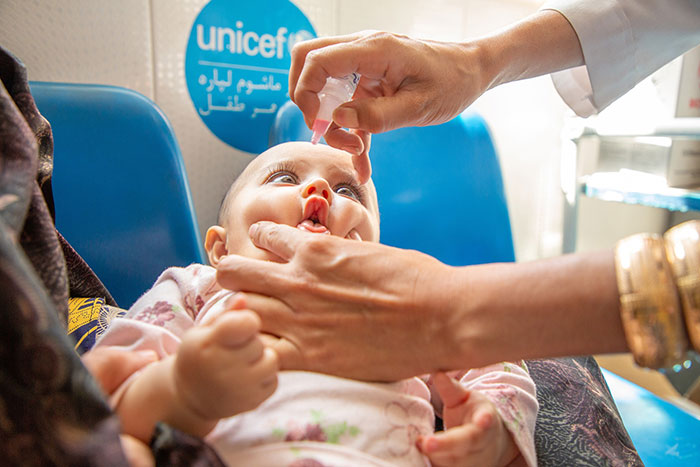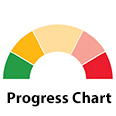Ensure healthy lives and promote well-being for all at all ages

A baby receives a dose of oral polio vaccine in a community health centre in Herat, western Afghanistan.
© UNICEF/Sharifa Khanhealth targets by 2030, a substantial intensification of efforts is needed to address deep-seated inequalities, strengthen primary care, build resilient and inclusive health systems and ensure universal access to quality care.
Global maternal deaths fall slightly, but progress stalls in high-burden countries
The global maternal mortality ratio (MMR) dropped from 228 deaths per 100,000 live births in 2015 to 197 in 2023. Despite progress, an estimated 260,000 women died during pregnancy and childbirth in 2023. The current ratio remains nearly triple the SDG target of 70. Meeting this target requires an annual reduction rate of 14.8 per cent between now and 2030.
Critical disparities persist. In 2023, the MMR in low-income countries stood at 346, compared to just 10 in high-income countries. Conflict-affected countries faced an MMR of 504, while countries experiencing institutional and social fragility had a ratio of 368. Furthermore, sub-Saharan Africa and Southern Asia, which together accounted for 87 per cent of global maternal deaths in 2023, have seen limited progress in reducing maternal mortality since 2015.
While the global proportion of births attended by skilled health personnel increased from 80 to 87 per cent between 2015 and 2024, some 17 million births still occurred without skilled assistance in 2024. Regional disparities remain stark: in sub-Saharan Africa coverage reached only 73 per cent, compared to 97 per cent in Eastern and South-Eastern Asia.
Under-5 mortality rate reveals significant gaps among the regions
Global under-5 mortality fell to 37 deaths per 1,000 live births in 2023, a 16 per cent reduction from 44 in 2015. Neonatal mortality dropped 12 per cent from 20 to 17 deaths per 1,000 live births. However, 4.8 million children under age 5 still died in 2023, down from 6.2 million deaths in 2015. Regional disparities remain stark: sub-Saharan Africa’s under-5 mortality rate of 69 deaths per 1,000 live births is 18 times higher than Australia and New Zealand’s rate. Progress has slowed down. The global annual rates of reduction for under-5 and neonatal mortality were 3.7 and 3 per cent, respectively, during the 2000–2015 period. However, these rates dropped to 2.2 and 1.6 per cent, respectively, for 2015–2023.
As of 2023, 133 countries had already met the SDG target for under-5 mortality, and 7 more are expected to do so by 2030. However, 60 countries ‒ nearly three quarters of them in sub-Saharan Africa ‒ must accelerate progress to meet the 2030 target for under-5 mortality. For neonatal mortality, 125 countries have met the SDG target and 10 more are expected to do so by 2030, but 65 countries need faster reductions. Current trends project 30 million under-5 deaths by 2030. Meeting SDG targets could prevent 8 million of these deaths.
Under-5 and neonatal mortality rate, 2015‒2023 (deaths per 1,000 live births)

* Excluding Australia and New Zealand.
The global fight against infectious diseases shows critical gains, though global targets remain out of reach
HIV/AIDS: Expanded HIV treatment access has halved AIDS-related deaths, from 1.3 million in 2010 to 630,000 in 2023. New HIV infections in 2023 reached their lowest since the late 1980s ‒ 39 per cent lower than in 2010, with sub-Saharan Africa seeing a 56 per cent reduction. However, an estimated 1.3 million people still contracted HIV in 2023. Concerningly, three regions, Europe and Northern America, Oceania (excluding Australia and New Zealand), and Northern Africa and Western Asia, experienced rising numbers of new HIV infections since 2010.
Of the estimated 39.9 million people living with HIV in 2023, 9.3 million were not receiving life-saving treatment ‒ resulting in one AIDS-related death every minute. HIV incidence among adolescent girls and young women remains exceptionally high in sub-Saharan Africa. Vertical transmission is declining more slowly, with an estimated 120,000 children acquiring HIV in 2023; this brings the total number of children living with HIV to 1.4 million, with 86 per cent in sub-Saharan Africa.
Around the world, funding is shrinking. As of December 2024, over 20 million people ‒ 560,000 of them children ‒ were receiving antiretroviral treatment through the support of the United States of America. In January 2025, the United States Government paused foreign assistance, which disrupted life-saving HIV services for millions across 55 countries, primarily in Africa. A permanent halt could result in 6 million new HIV infections and 4 million AIDS-related deaths by 2029. Domestic and donor financing remains insufficient to replace this support quickly, putting service continuity at risk. Despite the abrupt cuts, countries such as Botswana, Kenya and Nigeria have pledged to maintain services using domestic resources. Global solidarity remains essential to protect progress and save lives.
Tuberculosis: In 2023, an estimated 10.8 million people developed TB, a slight rise from 2022 ‒ mainly attributed to population growth. However, the increase in new TB cases since the start of the COVID-19 pandemic has slowed and stabilized. The burden of TB remains heavily concentrated, with 87 per cent of global cases in 30 high-burden countries. Men represented 55 per cent of these cases.
Encouragingly, TB-related deaths decreased to 1.25 million in 2023, falling below pre-pandemic levels and continuing the downward trend started in 2022. However, TB is likely once again the leading cause of death from a single infectious agent, surpassing COVID-19. The global TB incidence rate in 2023 was 134 per 100,000 population. Between 2015 and 2023, the incidence rate had reduced by only 8.3 per cent, falling short of the target set by the End TB Strategy of the World Health Organization (WHO), which aims for an 80 per cent reduction by 2030. African and European regions showed the most progress, with declines of 24 and 27 per cent, respectively.
Tuberculosis estimated incidence rate and case notification rate, 2015‒2023 (new cases per 100,000 population per year)

Malaria: Global malaria response efforts have averted an estimated 2.2 billion cases and 12.7 million deaths worldwide since 2000. By the end of 2024, 44 countries and one territory had been certified malaria-free, and many others were advancing towards eradication.
Despite progress, malaria persists as a grave global health challenge. There were an estimated 263 million malaria cases in 2023, an increase from 226 million in 2015. The global malaria incidence rate also rose to 60.4 cases per 1,000 population at risk in 2023, compared to 58 in 2015. The 2023 rate was nearly three times the target of the WHO Global Technical Strategy for Malaria.
Too many people at high risk still lack access to essential malaria services. In 2023, more than 40 per cent of children under age 5 and pregnant women in sub-Saharan Africa were not protected by insecticide-treated nets. Only 44 per cent of pregnant women in Africa received the recommended three-dose regimen of preventive malaria therapy.
Malaria case incidence, 2015‒2023 with projection to 2030 (cases per 1,000 population at risk)

Neglected tropical diseases (NTDs): The number of people requiring interventions for NTDs fell to 1.495 billion in 2023, a significant decrease from 2.19 billion in 2010 and approximately 122 million fewer than in 2022. This progress is reflected in the 54 countries that had eliminated at least one NTD by the end of 2024. Despite a 32 per cent global reduction in people needing interventions since 2010, this pace is currently insufficient to meet the 2030 target of a 90 per cent reduction. In LDCs the proportion of the population needing care for NTDs dropped substantially from 79 per cent in 2010 to 43 per cent in 2023. However, 493 million people in LDCs still required treatment and care for NTDs in 2023.
Number of people requiring interventions against neglected tropical diseases, 2010–2023 (billions)

Non-communicable diseases cause more than half the deaths for people under age 70
In 2021, an estimated 18 million people under the age of 70 died from non-communicable diseases (NCDs) globally ‒ accounting for more than half of all premature deaths. The risk of dying prematurely between ages 30 and 70 from one of the four main NCDs (cardiovascular disease, cancer, diabetes or chronic respiratory disease) declined from 22.5 per cent in 2000 to 18.4 per cent in 2015 and 18.0 per cent in 2019. However, progress plateaued during 2020–2021 in countries with reliable data. If pre-2019 trends resume, the risk of premature death is projected to fall to 16.3 per cent by 2030. However, neither the world nor its regions are on track to meet the SDG target of reducing premature NCD mortality by one third by 2030. Women face a lower risk of premature death from NCDs than men. In 2019, a 30-year-old man had a 21.6 per cent chance of dying from one of the four main NCDs before age 70, compared to the 14.4 per cent for women.
Risk of dying from cardiovascular disease, cancer, diabetes or chronic respiratory disease between ages 30 and 70 years, by sex, 2000–2019 (percentage)

* Excluding Australia and New Zealand.
Global tobacco and alcohol use is declining, but still cause immense health, economic and environmental burdens
Over the past two decades, global prevalence of tobacco use has fallen by one third, with an estimated 118 million fewer tobacco users today than in 2005. Despite this progress, an estimated 1.25 billion people still use tobacco globally, and tobacco use remains one of the main preventable risk factors for NCDs. Only 56 countries were on track to meet the target of a 30 per cent reduction in prevalence between 2010 and 2025 set by the WHO Global Action Plan for the Prevention and Control of Non-Communicable Diseases.
Beyond severe health consequences, tobacco use imposes substantial economic burdens. The economic cost of smoking, from health expenditures and productivity losses, was estimated at 1.8 per cent of the world’s annual GDP in 2012. Roughly 4.5 trillion cigarette butts are discarded every year into our environment ‒ the second highest form of plastic pollution. Valuable agricultural land and water are wasted on growing tobacco instead of food. Production and consumption of tobacco releases 80 million tons of carbon dioxide into the air every year.
Global alcohol consumption per capita (ages 15 and older) fell by 12 per cent from 5.7 litres of pure alcohol in 2010 to 5.0 litres in 2022. Globally, fewer women consume alcohol than men, and when they do, they tend to drink less. In 2019, 56 per cent of the world’s population aged 15 years or older (65 per cent of women and 48 per cent of men) abstained from drinking alcohol in the past 12 months. Despite some promising global trends in the prevalence of heavy episodic drinking and the number of age-standardized, alcohol-attributable deaths between 2010 and 2019, the overall burden of disease and injuries caused by the harmful use of alcohol is high, particularly in Africa and Europe.
Falling global suicide rate contrasts sharply with upward trends in some regions
Worldwide, an estimated 727,000 people died by suicide in 2021. While the global crude suicide rate showed progress, falling from 12.5 to 9.2 per 100,000 population between 2000 and 2021, this improvement was not universal. Significant decreases were observed in regions such as Central Asia (down 51 per cent), Europe (down 40 per cent) and Eastern Asia (down 37 per cent). However, during the same period, the crude suicide rate markedly increased in Northern America (up 33 per cent), Latin America and the Caribbean (up 25 per cent), and South-Eastern Asia (up 10 per cent). In 2021, the majority of suicides were found in low- and middle-income countries (73 per cent). Suicide prevention requires strong political commitment and coordinated action. WHO’s LIVE LIFE Initiative for Suicide Prevention promotes four key interventions: limiting access to means, encouraging responsible media reporting, building adolescents’ life skills and ensuring early support for those at risk.
Suicide death rate, 2000 and 2021 (deaths per 100,000 population)

* Excluding Australia and New Zealand.
More women use modern methods of contraception, and fewer adolescents give birth
The proportion of women of reproductive age (15–49 years) having their need for family planning satisfied with modern methods stands at 77.2 per cent in 2025, a slight increase from 76.4 per cent in 2015. Most regions have seen improvements, with sub-Saharan Africa experiencing the largest rise – from 51.6 to 57.9 per cent. Eastern and South-Eastern Asia remains the highest at over 86 per cent in 2025, though it is the only region to see a slight decline.
Substantial global progress has been made in reducing adolescent birth rates. Among girls aged 15–19 years, the global birth rate fell from 45.9 births per 1,000 in 2015 to 38.3 in 2024. For girls aged 10–14 years, the rate dropped from 1.5 per 1,000 in 2015 to 1.0 in 2024. Consequently, births to adolescent mothers decreased from 13.9 million in 2015 to 12.4 million in 2024. In Central and Southern Asia, the adolescent birth rate (ages 15–19 years) plummeted from 106 per 1,000 in 2000 to 25.1 in 2024. In contrast, sub-Saharan Africa, while experiencing some decline, continues to report the highest rates globally: 92.9 births per 1,000 women aged 15–19 years and 3.1 births per 1,000 girls aged 10–14 years in 2024.
Proportion of women of reproductive age (15–49 years) whose demand for family planning is satisfied with modern methods, 2015 and 2025 (percentage)

* Excluding Australia and New Zealand.
Vaccine delivery systems have not fully rebounded post-pandemic, making global targets unlikely
Between 2020 and 2022, global childhood immunization programmes experienced significant setbacks, with stagnation or dips in coverage for all four tracked childhood vaccines. In 2023, coverage for the third dose of the diphtheria, tetanus and pertussis (DTP3) vaccine – often used as a marker of a well-functioning routine immunization system – reached 84 per cent. That is still below pre-pandemic levels, indicating substantial residual dysfunction in global vaccine delivery systems.
While the other three tracked vaccines saw some increases in coverage, those were partly due to new national introductions rather than restored service levels. Global coverage for the human papilloma virus (HPV) vaccine among girls aged 9–14 years remains very low, with huge variations between countries. This leaves millions of girls worldwide susceptible to cervical cancer later in life. Measles outbreaks have surged in many countries due to inadequate coverage of the second dose of the measles vaccine (MCV2). If current trends continue, the global target of 90 per cent set by Immunization Agenda 2030 is unlikely to be met for any of these vaccinations.
Official development assistance for health sees sharp decline from pandemic peak, but remains above pre-pandemic levels
Gross official development assistance (ODA) for medical research and basic health totalled $13.4 billion in 2023, a 39 per cent decrease from the historic peak in 2022 of $22.1 billion (in constant 2023 prices), which was primarily driven by the response to the COVID-19 pandemic. Despite this post-pandemic reduction, ODA for medical research and basic health in 2023 was still 22.5 per cent higher than 2015 levels and slightly above 2019 levels. In 2023, $3.7 billion were spent for infectious disease control (excluding malaria, tuberculosis, COVID-19, HIV/AIDS and other sexually transmitted diseases); in addition, $2.4 billion went towards malaria control and $2.2 billion towards basic healthcare. Funding for COVID-19 control decreased by 78 per cent from 2022 to $1.9 billion in 2023. In 2023, LDCs received 40 per cent of the total ODA for medical research and basic health or $5.5 billion, a 20 per cent decrease from 2022.
Total official development assistance to medical research and basic health sectors, 2015–2023 (billions of constant 2023 dollars)

Despite a growing health workforce, a global shortage persists and is growing as the population expands and ages
In 2023, the global health workforce was estimated at over 70 million, with 52 million in the five key occupations (dentists, medical doctors, midwifery personnel, nursing personnel and pharmacists). A global shortage of 14.7 million health workers persisted in 2023, down from 15.4 million in 2020. The shortfall is projected to decline gradually to 11.1 million by 2030, with over half concentrated in Northern Africa and sub-Saharan Africa.
While the global density of the five key occupations rose by 26 per cent between 2013 and 2023, vast inequities remain: high-income countries average one health worker for every 64 people, compared to one for every 621 people in low-income countries. High- and upper-middle-income countries, which account for 53 per cent of the global population, employ 80 per cent of workers in these five key professions and consequently have the highest densities. But these countries will still need to recruit an estimated 8.4 million additional health workers by 2030 to sustain current levels and meet the growing demand driven by population growth and ageing.

